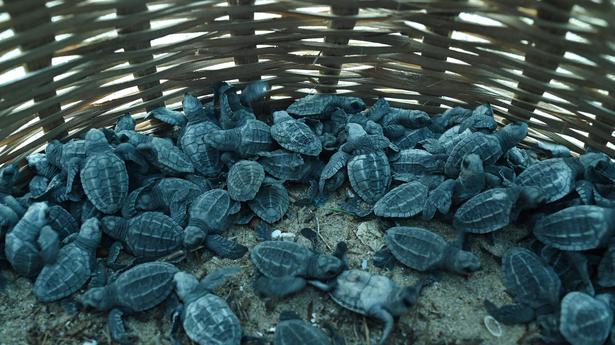
2.45 lakh Olive Ridley turtles arrive to nest at Gahirmatha
The Hindu
Concern over delay in annual ritual ends with one of the largest opening day arrivals of the turtles
About 2.45 lakh Olive Ridley sea turtles crawled ashore at the Nasi-II beach of the Gahirmatha Marine Sanctuary along the Odisha coast for laying eggs, marking one of the largest opening day arrivals of turtles at the site. Authorities of the State Forest and Environment Department have been apprehensive about the delay in annual nesting ritual of the species at Gahirmatha, the world’s largest rookery for endangered Olive Ridley sea turtles. When the annual spectacle began on Friday, it was a sight to behold.
“This year, the slope is in a perfect condition for turtles to climb up the beach. The blowing of the southerly wind makes the atmosphere conducive for turtles to congregate for laying eggs,” Jagyandatt Pati, Divisional Forest Officer, Mangrove Wildlife Division, Rajnagar, said.
Mr. Pati said the entire turtle congregation was noticed in the Nasi-II island of the Gahirmatha Sanctuary. Both Nasi-I and Nasi-II beaches are under the jurisdiction of the Defence Research and Development Organisation, which conducts missile tests from the nearby Wheeler Island.
“It is a matter of great satisfaction that Nasi-II is getting elongated due to natural processes over the past few years, which means there is more space for turtles to lay eggs,” Mr. Pati added.
In 2021, 3.49 lakh turtles arrived for laying eggs on March 9 and stayed for the mass nesting that continued for two weeks till March 23. This year, turtles could stay for four to seven days for nesting.
Olive Ridley turtles dig holes on the beach with their front flippers for hours. Subsequently, they use their hind flippers to scoop out sand to create a cavity. They lay 40-50 eggs in each hole and cover it again with sand. Before sunrise, the turtles return to the sea, leaving behind the eggs, which hatch after 40-60 days. The hatchlings are expected to emerge from the eggs in the month of May this year.
As the beach is not big enough to host such a large number of nests, Olive Ridley turtles often dig out previously laid eggs in order to make space for more. Thousands of eggs are thus destroyed in the natural process.











